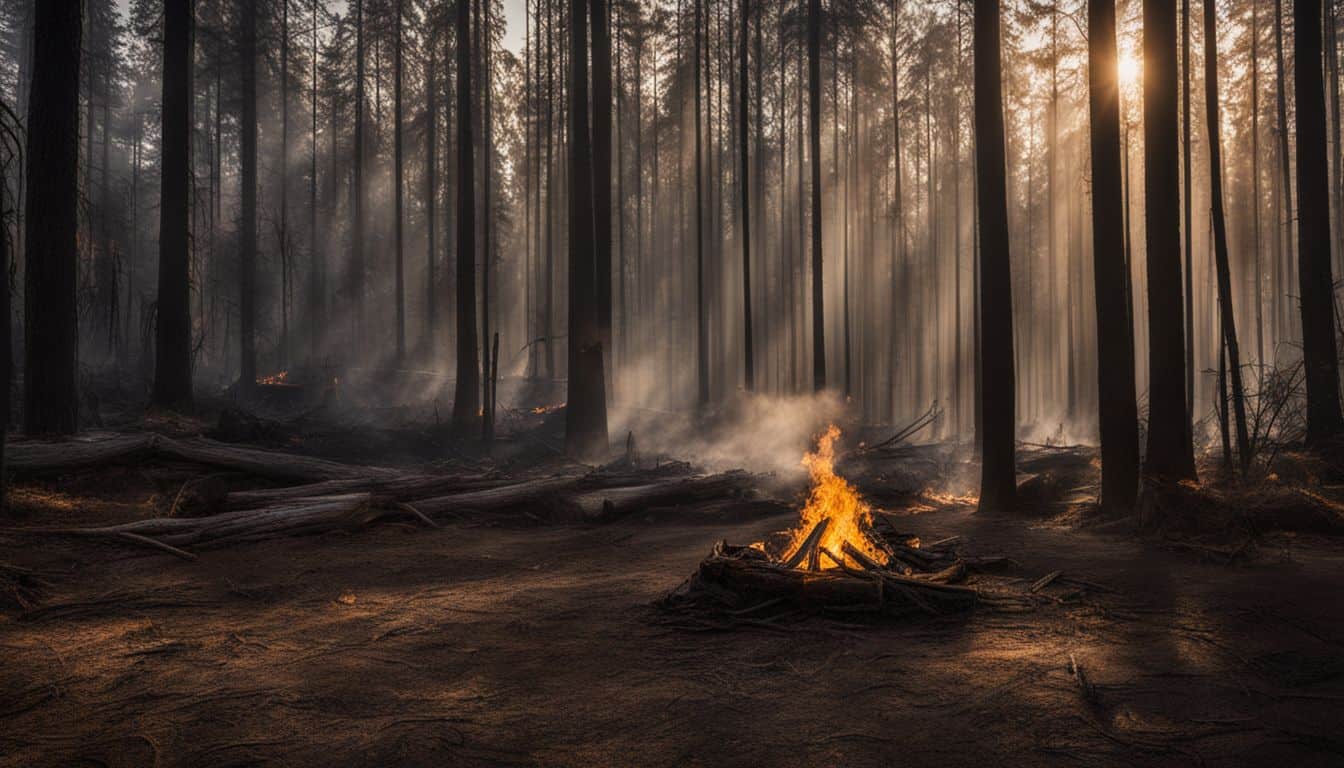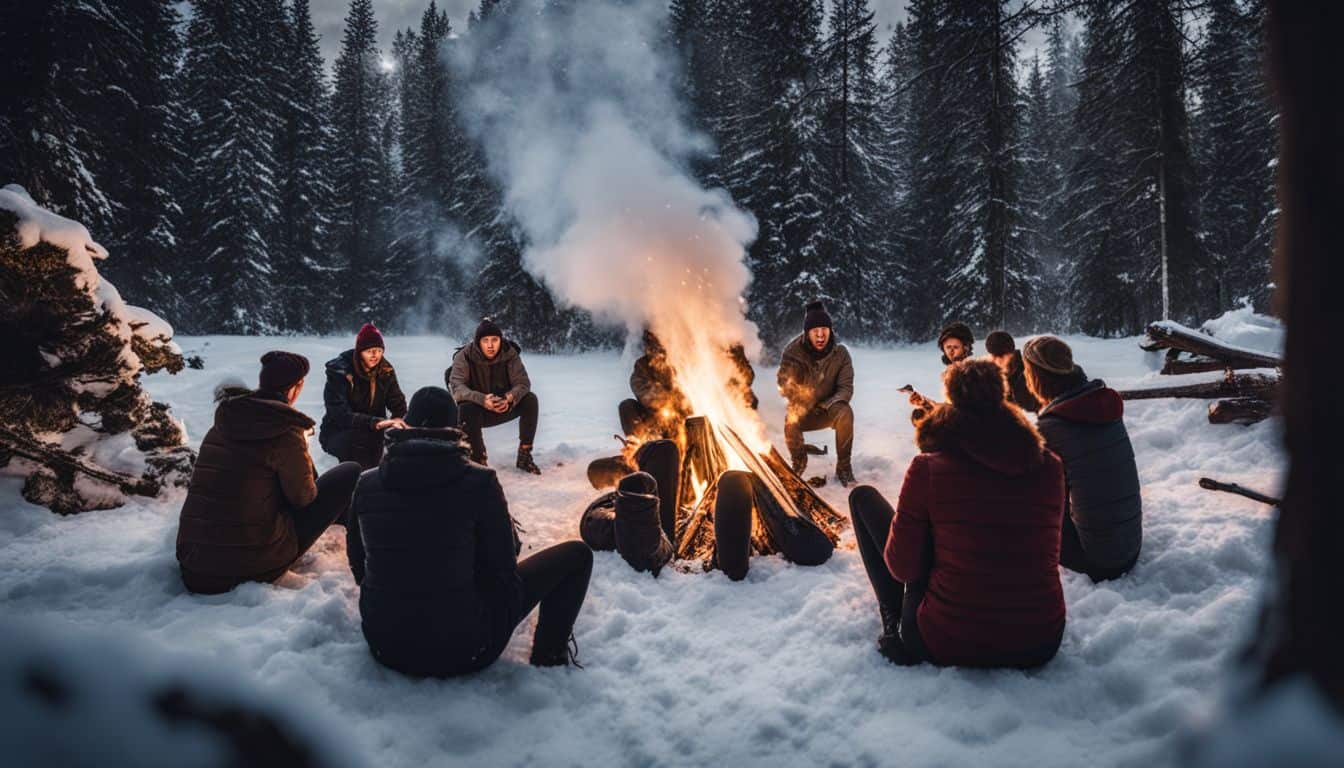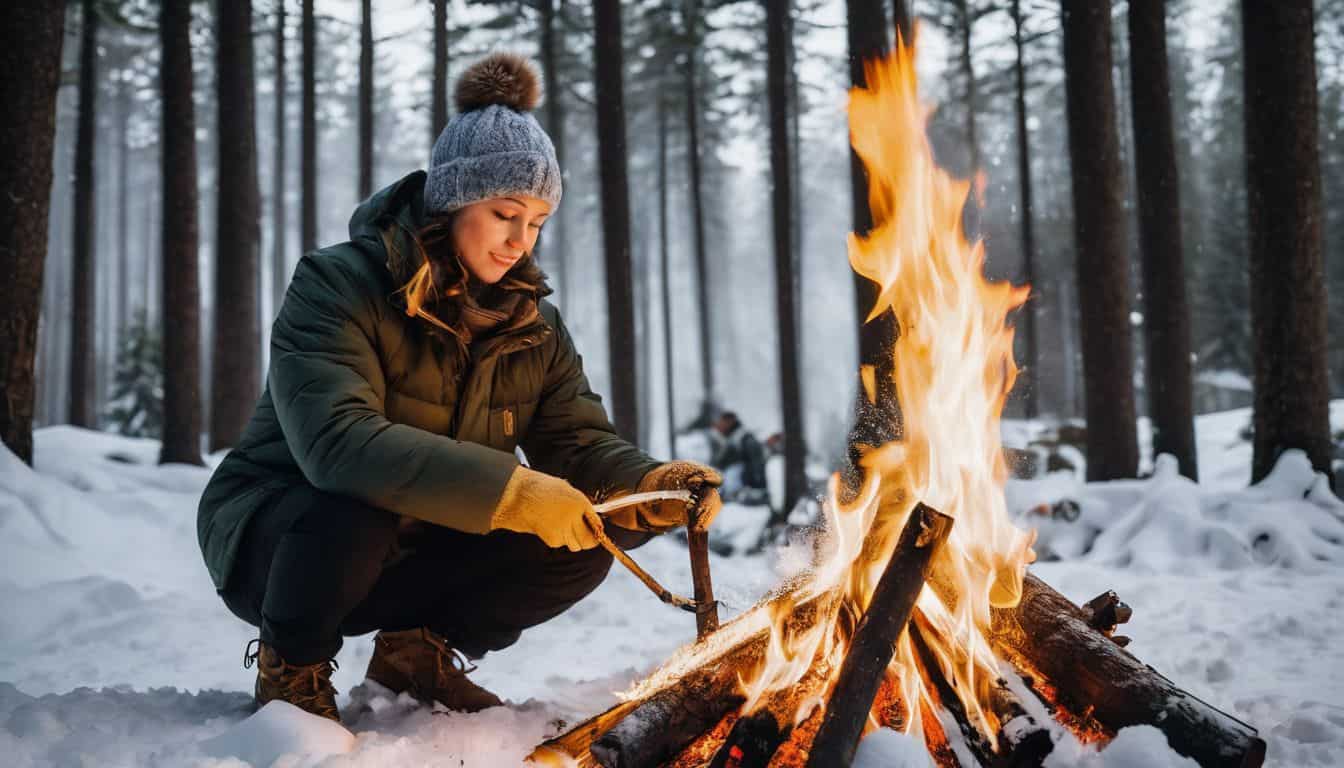Ever had one of those days when making a fire seems like solving an advanced calculus problem, especially when Mother Nature isn’t cooperating? Yeah, I’ve been in your shoes more times than I’d like to admit.
It turns out that a staggering 89% of annual wildfires are human-induced all because we sometimes underestimate the art of properly kindling and managing our fires. Dangerously ironic, right?.
That’s why I’m sharing “Fire making in different conditions: 5 Ways to Thrive.” A handy guide to keep you prepared and able to start a fire safely, no matter what your environment throws at you.
Ready to smoke these tips up and become a bona fide fire whisperer? Let’s turn up the heat!
Key Takeaways
- Fire is important for our survival and plays a crucial role in maintaining habitat for wildlife, promoting biodiversity, controlling woodland growth, preventing wildfires, and providing grasslands for animals.
- Understanding the basics of fire-making is essential for survival in different conditions. Fire needs oxygen, heat, and fuel to exist. Different conditions require different approaches to fire-making.
- To make a fire in different conditions, it’s important to prepare the area properly by clearing away flammable materials. Gathering the right materials like tinder, kindling, and firewood is crucial. Designing the fire based on factors like fuel moisture and weather patterns helps create a safe and efficient fire. Tending the fire by adding fuel as needed ensures its strength. Safety should always be prioritized when making fires in any condition.
- Fire-making techniques like using fire-activated seed can help plants survive after fires. Thermal insulation can either stop or spread fires depending on the type used.
Importance and Benefits of Fire
Fire is not only crucial for our survival, but it also plays a vital role in maintaining habitat for species, promoting biodiversity, controlling overgrowth of woodlands, preventing wildfires, and providing grasslands for wildlife.
Maintains habitat for species
Fire is a great tool for land care. It keeps places safe and nice for wildlife. Some animals and plants need different types of spaces to grow well. Fire makes sure these spaces are there.
As an example, the wild lupine plant needs fire to stay balanced in its place in nature. Using fire the right way also stops forests from getting too crowded with trees. This helps more types of plants and animals to live together, creating what we call biodiversity.
For some species that like sun and open areas, fire really helps them do well!
Promotes biodiversity
Fire is like a good friend to nature. It helps many plants and animals. Fire makes different types of homes for them. This is called promoting biodiversity.
Some fires are small and cool, others burn hot and fast. Each fire leaves behind a unique pattern on the land. Some areas stay untouched, while others get changed by the heat.
This mix makes more places for flowers to bloom and bugs to live in! These patches help lots of creatures find food and safe spots to raise babies.
Fire also keeps pests away from healthy trees. It helps stop diseases that can harm plants too!
Think about it this way: without fire, we lose many beautiful things in nature.
So yes, controlling fire can be hard work but it’s worth it! We need it to keep our wild places full of life.
Helps control overgrowth of woodlands
Fire can stop woods from getting too thick. This is called controlled burning or prescribed fire. Fire keeps the forest healthy and it’s cheaper than other ways to thin out trees. It makes open areas fresh again with plenty of rich grasslands.
It also helps control how much water is in wildland places and its quality.

Prevents wildfires
Prescribed fire is a crucial tool in preventing wildfires. By intentionally setting controlled fires, we can reduce the risk of larger and uncontrolled fires that pose a threat to our forests and communities.
These prescribed burns help manage forest health by reducing overcrowding and decreasing the severity and frequency of wildfires. It’s important to note that climate change, development, and poor forest management practices contribute to the increasing danger of wildfires.
To combat this, effective wildfire prevention measures and proper forest management strategies are necessary for the protection of our ecosystems and safety of our communities.
Provides grasslands for wildlife
Fire plays a crucial role in providing grasslands for wildlife. Native species of plants and animals rely on these open habitats to thrive. Some native plants even need occasional fires to grow properly, while fires can also help control invasive species that threaten the grassland ecosystem.
The presence of fire stimulates plant growth, which in turn attracts grazing animals like bison and deer. These grazing animals play an important part in maintaining the health and diversity of the grassland ecosystem.
In addition, the open habitat created by grasslands provides ideal conditions for burrowing animals and ground-dwelling birds to make their homes. Overall, fires contribute significantly to the preservation and conservation of wildlife in grasslands.
Basics of Fire-Making in Different Conditions

Understanding the basics of fire-making is an essential skill for survival in different conditions. Fire needs three elements to exist: oxygen, heat, and fuel. When these elements come together, a chemical reaction occurs, resulting in fire.
To start a fire, you need a source of heat, such as matches or a lighter. You also need fuel sources like dry twigs, leaves, or paper to ignite and sustain the flames. The oxygen supply is crucial for the fire to burn efficiently.
Different conditions require different approaches to fire-making. In wet conditions, it may be challenging to find dry materials for fuel. You might need to look for dead branches above ground level or use alternative methods like using birch bark as tinder.
In windy conditions, it’s important to shield your fire from strong gusts that can blow out the flames. Building windbreaks with rocks or logs can help protect your fire.
In cold conditions, having enough insulation around your fire helps retain heat and keep you warm. Adding thick layers of sticks or stones around the perimeter can act as thermal insulation.
Remember that safety should always be a priority when making fires in any condition. Clear away any flammable materials near your fire site and keep water nearby in case of emergencies.
By understanding these basic principles and adapting them to different conditions, you will be better equipped to thrive and survive in various environments by creating fires when needed.
How to Make a Fire in Different Conditions
To make a fire in different conditions, it is crucial to prepare the area, gather materials, design the fire properly, tend to it continuously, and prioritize safety at all times.
Preparing the area
Before making a fire, it’s crucial to prepare the area properly. This includes clearing away any dry brush or debris that could catch fire easily. It’s also important to choose a safe location for your fire, away from any flammable materials like trees or shrubs.
Remember to check the weather conditions as well, since strong winds can cause fires to spread quickly. By taking these precautions and preparing the area carefully, you can help ensure a safe and successful fire-making experience in different conditions.
Gathering materials
To make a fire in different conditions, you need to gather the right materials. Tinder, kindling, and firewood are important for a successful fire. Tinder is what you use to ignite the fire, like dry leaves or small twigs.
Kindling helps build up the flames and can be slightly larger sticks or branches. Firewood is the main fuel source that keeps the fire going. It’s important to collect these materials before starting your fire so you have everything you need.
Remember to gather enough of each material to sustain your fire for as long as you need it.
Designing the fire
When designing a fire in different conditions, it’s important to consider several factors. Fuel moisture, weather patterns, and fuel characteristics all play a role in determining how the fire will behave.
By understanding these factors, we can create a fire that is safe and effective.
Fuel moisture refers to the amount of water content in the materials being burned. Wetter fuels take longer to ignite and burn, while dry fuels catch fire more easily. Knowing the fuel moisture helps us determine how quickly the fire will spread and how intense it will be.
Weather patterns also influence fire behavior. Wind speed and direction can cause fires to spread rapidly or change direction unexpectedly. Temperature and humidity affect fuel conditions as well.
Hotter temperatures and lower humidity levels make fuels drier, increasing their flammability.
Tending the fire
To tend a fire properly, there are a few important things to keep in mind. First, you need to make sure that you have enough fuel to keep the fire going. This means gathering plenty of wood or other burnable materials before you start.
Then, it’s crucial to arrange the fuel in a way that allows for proper airflow and helps the fire burn efficiently. You can do this by stacking the wood loosely or creating a teepee shape.
Once your fire is burning steadily, you should periodically add more fuel to maintain its strength and heat. It’s also important to be mindful of safety while tending the fire – never leave it unattended and make sure it’s fully extinguished when you’re finished with it.
Ensuring safety
Safety is the most important thing when it comes to making a fire in different conditions. It’s crucial to avoid fire or sparks in hot, dry, and windy conditions because they can easily start a wildfire.
If the weather isn’t suitable for fire-making, choose non-flammable alternatives instead. Understanding the fuel conditions and weather is key as it can greatly affect wildland fires.
Having an escape plan in every building is essential since fire is a risk no matter where you are. Remember that removing heat, oxygen, or fuel can help prevent fires, so always consider these elements in your risk assessment.
Fire-Making Techniques for Thriving
To thrive in different conditions, mastering fire-making techniques is essential. Here are five strategies to ensure success: fire-activated seed, thermal insulation, resprouting, prolific flowering, and tall crowns.
With these techniques, you can not only survive but also thrive in challenging environments.
Fire-activated seed
Fire-activated seed is a really cool adaptation that some plants have to survive in places where fires happen often. These special seeds are stimulated by the heat from the fire and that makes them start growing.
It’s like the fire wakes them up! The seeds that have thick and hard coats are most likely to be activated by the fire. This helps these plants to grow and flourish after a fire has happened.
So basically, without fire, these plants wouldn’t be able to germinate and continue their life cycle. It’s amazing how nature finds ways to thrive even in challenging conditions!
Thermal insulation
Thermal insulation is really important when it comes to fire. It can either help stop the fire from spreading or actually make it worse. There are different codes and standards for thermal insulation that relate to fire safety.
Some types of insulation can catch on fire easily, while others can slow down how fast the fire spreads. The goal is to use insulation that reduces the rate of heat loss without adding fuel to a potential fire.
Cellulose insulation is one common type that helps keep heat inside buildings and prevents it from escaping outside.
Resprouting
Resprouting is a common way for plants to survive after a fire or intense browsing. It’s when new shoots grow from the base of a plant, allowing it to keep growing even after being damaged.
This regrowth helps plants adapt and thrive in different conditions. Some plants, like the lodgepole pine, even need fire to sprout their seeds! Resprouting is just one of the ways that plants use fire to their advantage and continue thriving in challenging environments.
Prolific flowering
Prolific flowering is an amazing phenomenon that occurs after a fire. When the land has been burned, some plants experience a burst of vibrant flowers. It’s like nature’s way of saying, “I’m still here!” This explosion of color not only looks beautiful but also plays an important role in reproduction.
The fire-stimulated species have an opportunity to mate and increase their chances of reproductive success. So, after a fire, you can expect to see these landscapes filled with colorful and thriving flowers, showcasing the resilience and adaptation of nature.
Some invasive plants have even adapted to take advantage of fire by starting to flower at a young age and dispersing their seeds through various means like wildlife or water. Fire is crucial for the germination and growth of certain plants, showing just how dependent they are on this natural process for their reproductive success.
Tall crowns
Tall crowns are an important strategy that some tree species use to protect themselves from wildfires. These trees have fewer lower branches and their leaves and branches are positioned higher up.
This helps reduce the amount of fuel available for fires because the leaves and vital parts of the trees are kept away from the ground where fires typically start. With tall crowns, trees can minimize the risk of crown fire spread and intensity, which is when fires move rapidly through treetops.
By having tall crowns, certain tree species can thrive in fire-prone environments and withstand wildfires more effectively.
Restoring Fire to Native Grasslands
Restoring fire to native grasslands is crucial for sustaining critical habitats for endangered birds, ensuring a healthy food chain, and preserving ecosystems that depend on fire.
Sustaining critical habitats for endangered birds
To ensure the survival of endangered birds, it is crucial to sustain their critical habitats. These habitats provide them with everything they need to thrive, from food and shelter to breeding grounds.
By restoring fire to native grasslands, we can maintain these habitats and protect the species that depend on them. Controlled burning plays a vital role in managing wildlife habitat by reducing invasive plants and promoting the growth of native vegetation.
This helps create a healthy food chain and preserves the delicate balance of ecosystems. Fire also encourages biodiversity preservation, ensuring that endangered birds have a safe place to call home.
Ensuring a healthy food chain
To ensure a healthy food chain, it is vital to restore fire to native grasslands. This helps in enriching the soil and preserving the natural ecosystem processes. By using prescribed burning techniques, we can manage grasslands effectively, enhance forage quality, and conserve biodiversity.
Restoring fire also benefits endangered birds that rely on these habitats for their survival. It is important to collaborate with organizations like The Nature Conservancy and follow safety protocols during controlled burns to achieve successful ecological restoration and maintain a thriving food chain.
Benefits of controlled fires
Controlled fires, also known as prescribed fires, have many benefits. They help restore fire to native grasslands and keep the ecosystem healthy. By using controlled burns, we can mimic the positive effects of wildfires while reducing the risks of uncontrolled fires.
Restoring fire to native grasslands through controlled burning helps maintain wildlife habitat and prevents forests from becoming too overcrowded. This is important for managing wildlife habitat and reducing the severity and frequency of wildfires.
Controlled burning is a well-planned approach that improves wildlife habitat and helps us take care of our environment. So let’s embrace the benefits of controlled fires for a thriving ecosystem!
Preserves that depend on fire
Preserves that depend on fire, like grasslands, forests, and prairies, rely on fire to maintain their health and diversity. Fire is a natural process that helps promote biodiversity by creating a patchwork of habitats.
It plays a crucial role in maintaining the stability and diversity of prairie ecosystems. Controlled burning, also known as prescribed burning, is used to prevent overgrowth and maintain the health of forests.
Native American communities have historically used fire to manage the land and promote specific species of plants and animals. So, fire is not always destructive but often necessary for ecological restoration and habitat management in these preserves.
Teamwork and Collaboration in Fire Management
Working together and collaborating with others is crucial in effective fire management. Organizations like The Nature Conservancy play a vital role in coordinating efforts and bringing people together to ensure controlled burns are carried out safely and efficiently.
This requires strong teamwork, communication, and adherence to strict safety protocols.
Importance of collaboration
Collaboration is extremely important when it comes to fire management. Working together as a team helps us solve problems faster and more effectively. It allows us to pool our resources, knowledge, and skills to keep everyone safe and achieve better results.
By partnering with organizations like The Nature Conservancy, we can coordinate our efforts and share information for successful controlled burns. Collaboration also builds trust and support among stakeholders, leading to stronger relationships in fire management.
Together, we can make a real difference in preserving habitats, preventing wildfires, and supporting indigenous communities’ rights. Let’s work together for a safer and healthier environment!
The role of organizations like The Nature Conservancy
Organizations like The Nature Conservancy play a crucial role in fire management and conservation. They partner with government agencies, Indigenous communities, and other organizations to bring the importance of fire back into focus.
Through their efforts, they use controlled burns to restore native grasslands and promote ecological benefits for both people and wildlife. For example, in North Carolina’s forests, controlled burning has been beneficial for wildlife preservation.
In addition, key nature preserves in Pennsylvania and Delaware also implement controlled burning as a conservation strategy. The Nature Conservancy actively engages in fire management and monitoring through partnerships with land managers and by conducting fire training exchanges (TREX).
Requirements for controlled burns
To carry out controlled burns, we need to consider several important requirements. These include factors such as temperature, humidity, wind conditions, soil moisture, and terrain.
The weather must be suitable for conducting the burn safely and effectively. Additionally, expertise in fire behavior is crucial to ensure the controlled burn achieves its intended goals without posing a risk of spreading uncontrollably.
Coordination between experts on the ground and various stakeholders is also essential to plan and execute controlled burns successfully. We must carefully consider factors like smoke dispersion and vegetation moisture to minimize any potential negative impacts while still achieving the desired outcomes.
Equipment and safety protocols
For me, as a survival enthusiast, it’s important to know about the equipment and safety protocols when it comes to fire management. Firefighting equipment and safety procedures are essential in preventing accidents and responding effectively to emergencies.
Risk assessment plays a crucial role in managing hazards and ensuring the safety of firefighters. It’s also important to maintain fire prevention measures, including proper maintenance of equipment and wearing protective gear.
Operators of fire apparatus should always follow safety guidelines to keep themselves and others safe. Situational awareness is key in fire management, so I make sure to review checklists and standards for guidance on maintaining situational awareness during firefighting operations.
The Benefits of Thriving in Challenging Conditions
Thriving in challenging conditions allows us to grow, overcome adversity, find purpose and fulfillment, and ultimately achieve success. Discover how fire-making techniques can help you thrive in different environments.
Read more to learn about the benefits of embracing challenges and thriving on purpose.
Personal growth and resilience
Personal growth and resilience are crucial qualities for thriving in challenging conditions. When facing difficult situations, such as starting a fire in different weather conditions or surviving in the wilderness, it is important to develop mental toughness and emotional intelligence.
Resilience allows us to bounce back from setbacks and adapt to changes. By cultivating perseverance, coping skills, and a growth mindset, we can overcome adversity and find purpose and fulfillment.
It’s about having the self-confidence to problem-solve and the ability to reflect on oneself. Remember that personal growth and resilience are not just limited to survival skills but also play a significant role in our everyday lives.
Overcoming adversity
When facing difficult circumstances, it’s important to develop the resilience needed to overcome adversity. I believe that setbacks and challenges are opportunities for personal growth and finding fulfillment in life.
By building resilience, we can bounce back from misfortunes and cope with hardships more effectively. Resilience is not about avoiding or ignoring difficulties, but rather about developing coping strategies and a thriving mindset.
It’s about making the best of situations and using past experiences as tools for handling future challenges. Thriving in challenging conditions requires determination, perseverance, and a willingness to adapt.
Finding purpose and fulfillment
When it comes to fire-making in different conditions, finding purpose and fulfillment is essential. It’s about building resilience and tapping into our natural tendencies as survival enthusiasts.
By aligning personal goals with the larger vision of the tasks at hand, we can boost motivation and engagement. Flexing our character strengths, like determination and resourcefulness, not only helps us overcome challenges but also leads to positive emotions, stronger relationships, increased vitality, and engaging in meaningful activities that bring us joy.
Grit plays a crucial role here too – a combination of passion and perseverance is key for finding purpose and fulfillment in challenging situations. It’s important to remember that without passion, perseverance alone can lead to burnout.
Achieving success
Achieving success is not always easy, especially when facing challenging conditions. However, it is through these difficult situations that we have the opportunity to grow and thrive.
Making decisions that align with our goals and values is crucial in shaping our path to success. By overcoming adversity and building resilience, we can navigate through any crisis or setback that comes our way.
Successful individuals are proactive, innovative, and resourceful, taking risks and turning ideas into action. It’s important to remember that success is not just about reaching a destination but also about the journey itself – the personal growth, perseverance, adaptability, and entrepreneurship that come along the way.
Conclusion on Fire-Making in Different Conditions
In conclusion, understanding the basics of fire-making in different conditions is crucial for survival enthusiasts. By gathering materials, designing and tending the fire, and ensuring safety, one can successfully start a fire.
Incorporating fire-making techniques like fire-activated seed and thermal insulation can also help us thrive in challenging environments. Remember, practicing these skills not only promotes resilience but also contributes to the health of ecosystems and habitats.
So get your spark ready and embrace the adventure of thriving through fire-making!
FAQs on Fire-Making in Different Conditions
1. How can I start a fire in wet conditions?
To start a fire in wet conditions, you can use materials such as dry leaves, birch bark, or small twigs as tinder and gradually build up with larger pieces of dry wood.
2. What are some methods to start a fire without matches or a lighter?
You can start a fire without matches or a lighter by using alternative methods like friction-based techniques (rubbing two sticks together), using a magnifying glass to focus sunlight on tinder, or creating sparks with flint and steel.
3. Can I make an emergency fire indoors?
No, it is not safe to make an emergency fire indoors due to the risk of carbon monoxide poisoning and potential damage to property. Emergency fires should only be made outdoors in designated areas.
4. How do I safely extinguish a campfire?
To safely extinguish a campfire, first allow the wood to burn down completely until there are only ashes left. Then pour water over the ashes and stir them with a stick until they are cool to the touch.
5. Are there any precautions I should take when making a fire outdoors?
Yes, when making a fire outdoors, it’s important to follow safety guidelines such as clearing the area around the fire pit from flammable materials, keeping water nearby for emergencies, and never leaving the fire unattended.





Leave a Reply